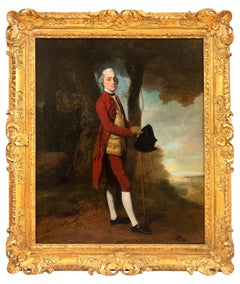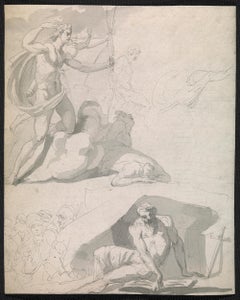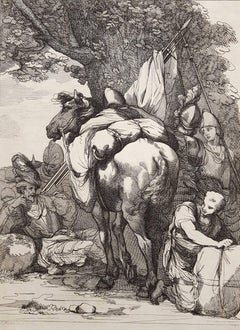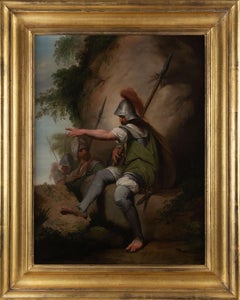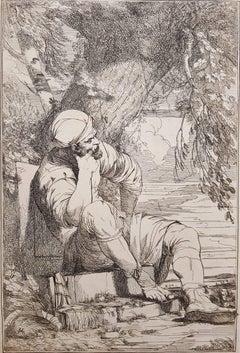John Hamilton Mortimer Art
English, 1740-1779
John Hamilton Mortimer was a British figure and landscape painter and printmaker, known for romantic paintings set in Italy, works depicting conversations and works drawn in the 1770s portraying war scenes, similar to those of Salvator Rosa. Mortimer became President of the Society of Artists in 1774, five years before his death, at age 39.
to
1
3
1
3
3
1
3
1
Overall Height
to
Overall Width
to
2
4
3
2
2
2
1
1
1
4
4
4
6,886
3,210
2,514
1,217
2
2
1
1
1
Artist: John Hamilton Mortimer
An English 18th century portrait of James Stanley, standing in a landscape
By John Hamilton Mortimer
Located in Bath, Somerset
Portrait of James Stanley (1750 - 1810), circa 1775-1778, full-length, wearing a red coat and breeches and a gold embroidered waistcoat, hold...
Category
1770s English School John Hamilton Mortimer Art
Materials
Oil, Canvas, ABS
Eighteenth century Old Master drawing - St Jerome
By John Hamilton Mortimer
Located in London, GB
Pen, ink and wash
Framed dimensions: 9 ½ x 11 ¼ inches
Drawn c. 1763
This small, powerful study shows St Jerome contemplating the bible with a cross and sk...
Category
18th Century Old Masters John Hamilton Mortimer Art
Materials
Ink, Pen
Eighteenth century Old Master drawing - Apollo destroying Niobe's children
By John Hamilton Mortimer
Located in London, GB
Pen, ink and wash
Framed dimensions: 13 x 11 ¼ inches
Drawn c.1765
Verso: a study of a hanged man
Mortimer has filled this small sheet with action, depicting in the top right, Apollo and Artemis...
Category
18th Century Old Masters John Hamilton Mortimer Art
Materials
Ink, Pen
Packhorse and Soldiers /// Antique British Victorian Etching Figurative Animal
By John Hamilton Mortimer
Located in Saint Augustine, FL
Artist: (after) John Hamilton Mortimer (English, 1740-1779)
Title: "Packhorse and Soldier"
Year: 1783
Medium: Original Etching on watermarked laid paper
Limited edition: Unknown
Prin...
Category
1780s Pre-Raphaelite John Hamilton Mortimer Art
Materials
Intaglio, Laid Paper, Etching
Related Items
Hand-Colored Penguin Engraving
By George Edwards
Located in New York, NY
Original engraving, hand-colored at the time of publication, after the work of George Edwards from "Sammlung verschneider auslandischer und seltener Vogel" by Johann Michael Seligma...
Category
Mid-18th Century John Hamilton Mortimer Art
Materials
Laid Paper
The Abduction of the Sabine Women , a Renaissance drawing by Biagio Pupini
Located in PARIS, FR
This vigorous drawing has long been attributed to Polidoro da Caravaggio: The Abduction of the Sabine Women is one of the scenes that Polidoro depicted between 1525 and 1527 on the façade of the Milesi Palazzo in Rome. However, the proximity to another drawing inspired by this same façade, kept at the Ecole des Beaux-Arts, and to other drawings inspired by Polidoro kept at the Musée du Louvre, leads us to propose an attribution to Biagio Pupini, a Bolognese artist whose life remains barely known, despite the abundant number of drawings attributed to him.
1. Biagio Pupini, a Bolognese artist in the light of the Roman Renaissance
The early life of Biagio Pupini, an important figure of the first half of the Cinquecento in Bologna - Vasari mentions him several times - is still poorly known. Neither his date of birth (probably around 1490-1495) nor his training are known. He is said to have been a pupil of Francesco Francia (1450 - 1517) and his name appears for the first time in 1511 in a contract with the painter Bagnacavallo (c. 1484 - 1542) for the frescoes of a church in Faenza. He then collaborated with Girolamo da Carpi, at San Michele in Bosco and at the villa of Belriguardo.
He must have gone to Rome for the first time with Bagnacavallo between 1511 and 1519. There he discovered the art of Raphael, with whom he might have worked, and that of Polidoro da Caravaggio. This first visit, and those that followed, were the occasion for an intense study of ancient and modern art, as illustrated by his abundant graphic production.
Polidoro da Caravaggio had a particular influence on the technique adopted by Pupini. Executed on coloured paper, his drawings generally combine pen, brown ink and wash with abundant highlights of white gouache, as in the drawing presented here.
2. The Abduction of the Sabine Women
Our drawing is an adaptation of a fresco painted between 1525 and 1527 by Polidoro da Caravaggio on the façade of the Milesi Palace in Rome. These painted façades were very famous from the moment they were painted and inspired many artists during their stay in Rome. These frescoes are now very deteriorated and difficult to see, as the palace is in a rather narrow street.
The episode of the abduction of the Sabine women (which appears in the centre of the photo above) is a historical theme that goes back to the origins of Rome and is recounted both by Titus Livius (Ab Urbe condita I,13), by Ovid (Fasti III, 199-228) and by Plutarch (II, Romulus 14-19). After killing his twin brother Romus, Romulus populates the city of Rome by opening it up to refugees and brigands and finds himself with an excess of men. Because of their reputation, none of the inhabitants of the neighbouring cities want to give them their daughters in marriage. The Romans then decide to invite their Sabine neighbours to a great feast during which they slaughter the Sabines and kidnap their daughters.
The engraving made by Giovanni Battista Gallestruzzi (1618 - 1677) around 1656-1658 gives us a good understanding of the Polidoro fresco, allowing us to see how Biagio Pupini reworked the scene to extract this dynamic group.
With a remarkable economy of means, Biagio Pupini takes over the left-hand side of the fresco and depicts in a very dense space two main groups, each consisting of a Roman and a Sabine, completed by a group of three soldiers in the background (which seems to differ quite significantly from Polidoro's composition).
The balance of the drawing is based on a very strongly structured composition. The drawing is organised around a median vertical axis, which runs along both the elbow of the kidnapped Sabine on the left and the foot of her captor, and the two main diagonals, reinforced by four secondary diagonals. This diamond-shaped structure creates an extremely dynamic space, in which centripetal movements (the legs of the Sabine on the right, the arm of the soldier on the back at the top right) and centrifugal movements (the arm of the kidnapper on the left and the legs of the Sabine he is carrying away, the arm of the Sabine on the right) oppose each other, giving the drawing the appearance of a whirlpool around a central point of support situated slightly to the left of the navel of the kidnapper on the right.
3. Polidoro da Caravaggio, and the decorations of Roman palaces
Polidoro da Caravaggio was a paradoxical artist who entered Raphael's (1483 - 1520) workshop at a very young age, when he oversaw the Lodges in the Vatican. Most of his Roman work, which was the peak of his career, has disappeared, as he specialised in facade painting, and yet these paintings, which are eminently visible in urban spaces, have influenced generations of artists who copied them abundantly during their visits to Rome.
Polidoro Caldara was born in Caravaggio around 1495-1500 (the birthplace of Michelangelo Merisi, known as Caravaggio, who was born there in 1571), some forty kilometres east of Milan. According to Vasari, he arrived as a mason on the Vatican's construction site and joined Raphael's workshop around 1517 (at the age of eighteen according to Vasari). This integration would have allowed Polidoro to work not only on the frescoes of the Lodges, but also on some of the frescoes of the Chambers, as well as on the flat of Cardinal Bibiena in the Vatican.
After Raphael's death in 1520, Polidoro worked first with Perin del Vaga before joining forces with Maturino of Florence (1490 - 1528), whom he had also known in Raphael's workshop. Together they specialised in the painting of palace façades. They were to produce some forty façades decorated with grisaille paintings imitating antique bas-reliefs.
The Sack of Rome in 1527, during which his friend Maturino was killed, led Polidoro to flee first to Naples (where he had already stayed in 1523), then to Messina. It was while he was preparing his return to the peninsula that he was murdered by one of his assistants, Tonno Calabrese, in 1543.
In his Vite, Vasari celebrated Polidoro as the greatest façade decorator of his time, noting that "there is no flat, palace, garden or villa in Rome that does not contain a work by Polidoro". Polidoro's facade decorations, most of which have disappeared as they were displayed in the open air, constitute the most important lost chapter of Roman art of the Cinquecento. The few surviving drawings of the painter can, however, give an idea of the original appearance of his murals and show that he was an artist of remarkable and highly original genius.
4. The façade of the Milesi Palace
Giovanni Antonio Milesi, who commissioned this palace, located not far from the Tiber, north of Piazza Navona, was a native of the Bergamo area, like Polidoro, with whom he maintained close friendly ties. Executed in the last years before the Sack of Rome, around 1526-1527, the decoration of Palazzo Milesi is considered Polidoro's greatest decorative success.
An engraving by Ernesto Maccari made at the end of the nineteenth century allows us to understand the general balance of this façade, which was still well preserved at the time. The frescoes were not entirely monochrome, but alternated elements in chiaroscuro simulating marble bas-reliefs and those in ochre simulating bronze and gold vases...
Category
16th Century Old Masters John Hamilton Mortimer Art
Materials
Ink, Gouache, Pen
Portrait de Priscilla Le Petit Chien
By Mickalene Thomas
Located in New York, NY
Mickalene Thomas
Portrait de Priscilla Le Petit Chien, 2012
Pigment print on 100% cotton rag paper
Edition 148/150
Frame included with official COA affixed to the back
Hand numbered from the edition of only 150 with plate signed official Certificate of Authenticity on the verso of the frame.
This exquisite print, published in 2012, is based on an original collage made by the artist of her long-haired miniature dachshund (a gift from fellow artist Kehinde Wiley), Priscilla. Highly acclaimed contemporary art star Mickalene Thomas created this collage specifically for children- though adults will appreciate it as well - as will pet lovers!
Portrait de Priscilla Petit Chien features Priscilla, Thomas' own dog who frequently attends the artist's photoshoots. This limited edition archival pigment print is printed on cotton rag paper and accompanied by a plate (facsimile) signed and uniquely hand numbered certificate of authenticity. It is matted and comes in a 1"-deep wooden frame with Plexiglas®. Wired for hanging. Edition of 150. This professionally framed limited edition pigment print on 100% cotton rag paper is based on an original collage made by the artist of her long-haired miniature dachshund (a gift from fellow artist Kehinde Wiley), Priscilla. The print is matted and comes in a white wooden frame (16" x 19" x 1") with Plexiglas, wired for hanging. Dimensions: 11" x 14" sheet, 9-1/4" x 12" image.
Mickalene Thomas Biography:
Mickalene Thomas (b. 1971, Camden, NJ; lives and works in Brooklyn, NY) makes paintings, collages, photography, video, and installations that draw on art history and popular culture to create a contemporary vision of female sexuality, beauty, and power. Blurring the distinction between object and subject, concrete and abstract, real and imaginary, Thomas constructs complex portraits, landscapes, and interiors in order to examine how identity, gender, and sense of self are informed by the ways women are represented in art and popular culture. Rhinestones—the artist’s signature material and a symbol of femininity—serve as an added layer of meaning and a metaphor of artifice. Thomas uses rhinestones to shade and accentuate specific elements of each painting, while subtly confronting our assumptions about what is feminine and what defines women.
Thomas has drawn inspiration from multiple artistic periods and cultural influences throughout Western art history, particularly the early modernists such as Jean-Auguste-Dominique Ingres, Pablo Picasso, Henri Matisse, Edouard Manet, and Romare Bearden. She models her figures on the classic poses and abstract settings popularized by these modern masters as a way to reclaim agency for women who have been presented as objects to be desired or subjugated. Though Thomas draws from a number of time periods and genres, her use of pattern and domestic spaces often references various periods throughout the 1960s to the 1980s. This was a time of immense social and political conflict, change, and transformation—the civil rights movement, the black is beautiful movement, and the second wave of feminism—during which many women, particularly African-Americans, rejected and redefined traditional standards of beauty.
Thomas received a BFA from the Pratt Institute, Brooklyn, NY, in 2000 and an MFA from Yale University School of Art, New Haven, CT, in 2002. Solo exhibitions of her work have been organized at The Dayton Art Institute, OH (forthcoming, 2018); Henry Art Gallery, Seattle, WA (forthcoming, 2018); Pomona College Museum of Art, Claremont, CA (forthcoming, 2018); Georgia Museum of Art, Athens, GA (forthcoming, 2017); Newcomb Art Museum, Tulane University, New Orleans, LA (2017); Spelman College Museum of Fine Art, Atlanta, GA (2017); Museum of Contemporary Art, Los Angeles (2016); Aspen Art Museum, CO (2016); Aperture Foundation, New York (2016); George Eastman Museum, Rochester, NY (2014); Brooklyn Museum, New York (2012-13); Santa Monica Museum of Art (2012); Institute of Contemporary Art, Boston (2012); Hara Museum of Contemporary Art, Tokyo (2011); and La Conservera Centro de Arte Contemporaneo, Ceuti, Spain (2009). Select group exhibitions featuring her work include Third Space / Shifting Conversations About Contemporary Art, Birmingham Museum of Art, AL (2017); Constructing Identity: Petrucci Family Foundation Collection of African-American Art, Portland Art Museum, ME (2017); The Color Line: African American Artists and the Civil Rights in the United States, Musée du quai Branly, Paris (2016); SHE: International Women Artists, Long Museum, Shanghai (2016); No Man’s Land: Women Artists from the Rubell Family Collection, Rubell Family Collection, Miami, traveled to the National Museum of Women in the Arts, Washington, DC (2015); 30 Americans, Corcoran Gallery of Art, Washington, DC (2011), which has traveled extensively around the United States (2011-2017, ongoing); and Americans Now, National Portrait Gallery, Washington, DC (2010). Thomas’ work is in numerous international public and private collections, including The Museum of Modern Art, New York; San Francisco Museum of Modern Art; Solomon R. Guggenheim Museum, New York; Whitney Museum of American Art, New York; Museum of Fine Arts, Boston; Art Institute of Chicago; MoMA PS1, New York; Brooklyn Museum, New York; Studio Museum in Harlem, New York; Yale University Art Collection, New Haven, CT; and Hara Museum of Contemporary Art, Tokyo.
Thomas has been awarded multiple prizes and grants, including the USA Francie Bishop Good & David Horvitz...
Category
2010s Realist John Hamilton Mortimer Art
Materials
Digital Pigment, Permanent Marker, Laid Paper
Follower of Francesco Guardi, Figures in a Mediterranean port by a Roman Arch
By Francesco Guardi
Located in Harkstead, GB
A lively, well executed sketch painted by a 19th century follower of Francesco Guardi
Follower of Francesco Guardi, 19th Century
Figures by a Roman Arch
Watercolour with ink and sc...
Category
19th Century Old Masters John Hamilton Mortimer Art
Materials
Paper, Ink, Watercolor
Free Shipping
H 6.5 in W 5 in D 1 in
Large Signed Surreal Nude Male Portrait Symbolist Landscape Framed Oil Painting
Located in Buffalo, NY
Antique American school modernist landscape with male figures. Really well painted and a very interesting composition. Impressive giltwood frame as well! Signed and dated lower ri...
Category
1990s Surrealist John Hamilton Mortimer Art
Materials
Oil, Canvas
H 20 in W 47 in D 2 in
Antique Paris School Early 1900's French Impressionist Portrait Oil Painting
Located in Buffalo, NY
Antique French impressionist portrait oil painting of two young girls. Oil on board. No signature found. Framed. Image size, 10L x 18H.
Category
1920s Impressionist John Hamilton Mortimer Art
Materials
Canvas, Oil
H 23 in W 15 in D 2 in
Venice Landscape Italian Oil on Canvas Painting in Gilt Wood Frame, Belle Epoque
Located in Firenze, IT
This delightful turn of the century (early 20th century) oil on canvas painting represents an Italian landscape with one of the most famous squares in the world: Piazza San Marco in ...
Category
Early 20th Century Impressionist John Hamilton Mortimer Art
Materials
Canvas, Oil
Venice Landscape Italian Oil on Canvas Painting in Gilt Wood Frame, Belle Epoque, Early 20th Century
H 51.19 in W 33.47 in D 1.19 in
people from ibiza Spain oil on canvas painting spanish urbanscape
By Ignacio Gil Sala
Located in Barcelona, Barcelona
Ignacio Gil Sala (1913-2003) - Characters from Ibiza - Oil on canvas
Oil measures 50x61 cm.
Frameless.
Ignacio Gil Sala, was a painter, bohemian character, adventurous and intrepid traveler who knew how to capture his eyes to that world with his painting. After starting his artistic training at the age of nine, Gil Sala entered the School of Fine Arts in Barcelona, where he had as teachers Felix Mestres and Vicente Borrás. Already in 1930, being still almost an apprentice, he obtained the bronze medal of the School, and in 1936 he won by contest a scholarship to make a study trip through Spain. Those were the difficult moments of the outbreak of the Civil War and thanks to the help of the sculptor Mariano Benlliure, he was able to complete his artistic training. Throughout his life Ignacio Gil dedicated himself to travel both in the Peninsula and in different Islamic and Latin American countries. He exhibited his work in Spain, France, the Philippines, Switzerland, the United States, Canada and Colombia, among many other countries.
Extraordinary draftsman, agile handling pencil and charcoal, Ignacio Gil immortalized landscapes of all Spain...
Category
1980s Post-Impressionist John Hamilton Mortimer Art
Materials
Oil, Canvas
Louis-Félix de La Rue (1730-1777) A Mythological scene, drawing
By Louis-Félix Delarue
Located in Paris, FR
Louis-Félix de La Rue (1730-1777)
A biblical or mythological episode
Signed and dated lower right (under the mount, see photos of the drawing out of frame)
...
Category
1770s Old Masters John Hamilton Mortimer Art
Materials
Ink
Louis Lesueur (1746-1803) Landscape with ruins, 1789, drawing signed and dated
Located in Paris, FR
Louis Lesueur (1746-1803)
A Fantasy Landscape with ancient ruins, 1789,
signed and dated "L Lesueur 1789" in the bottom centre
Pen and ink and ink wash on paper
14.8 x 22 cm
In goo...
Category
1780s Old Masters John Hamilton Mortimer Art
Materials
Ink
Museum Quality American School School Young Woman Portrait Framed Oil Painting
Located in Buffalo, NY
Incredible quality American school portrait painting. Oil on canvas. Framed. No signature found.
Category
1880s Realist John Hamilton Mortimer Art
Materials
Oil, Canvas
H 17 in W 15 in D 2 in
Fine 1700's Italian Old Master Ink & Wash Drawing Roman Female Statue of Beauty
Located in Cirencester, Gloucestershire
Belleza (The Art of Beauty)
Italian School, 18th century
ink and wash drawing on paper, framed within a light oak wood frame (behind glass)
image size: 10.5 x 7 inches
overall framed...
Category
18th Century Old Masters John Hamilton Mortimer Art
Materials
Ink, Archival Paper, Watercolor
Previously Available Items
18th century painting of a bandit taking up his post
By John Hamilton Mortimer
Located in London, GB
Collections:
Pulteney Hotel, Bath;
Private collection, Denmark;
Christian B. Peper, acquired in 1985, to 2012.
Literature:
G. Benthall, John Hamilton Mortimer ARA: Drawing and Eng...
Category
18th Century Old Masters John Hamilton Mortimer Art
Materials
Oil, Canvas
Reposo
By John Hamilton Mortimer
Located in Saint Augustine, FL
An original etching on heavy wove paper by English artist John Hamilton Mortimer (1740-1779) titled "Reposo", 1778. Monogram signed in the plate (printed signature) by Mortimer lower...
Category
1770s Pre-Raphaelite John Hamilton Mortimer Art
Materials
Etching
Miller of Trompington and Two Scholars
By John Hamilton Mortimer
Located in Saint Augustine, FL
An original engraving on wove paper after English artist John Hamilton Mortimer (1740-1779) titled "Miller of Trompington and Two Scholars", 1787. Engraved by English artist William ...
Category
1780s Victorian John Hamilton Mortimer Art
Materials
Engraving
John Hamilton Mortimer art for sale on 1stDibs.
Find a wide variety of authentic John Hamilton Mortimer art available for sale on 1stDibs. You can also browse by medium to find art by John Hamilton Mortimer in ink, pen, abs and more. Much of the original work by this artist or collective was created during the 18th century and is mostly associated with the Old Masters style. Not every interior allows for large John Hamilton Mortimer art, so small editions measuring 7 inches across are available. Customers who are interested in this artist might also find the work of George Romney, Jan Pieter Verdussen, and Émile Jean-Horace Vernet . John Hamilton Mortimer art prices can differ depending upon medium, time period and other attributes. On 1stDibs, the price for these items starts at $450 and tops out at $21,660, while the average work can sell for $8,052.
Artists Similar to John Hamilton Mortimer
Carle Vernet (Antoine Charles Horace Vernet)
